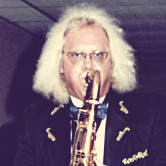Common Transpositions
Paul R. Coats
By the time a young Saxophonist gets into high school he may be asked by his director to play from a part written for another (missing) instrument. The versatile tone of the saxophone is often called upon for these chores, substituting for Oboe, Bassoon, Cello, or other instruments. Fortunately, this should not be as terrifying as first thought.
A player will generally not be asked to perform a part for which his instrument is clearly unsuited. A Tenor Saxophonist will not be asked to play a Piccolo part, for example, but may be asked to play a Cello part.
There is one simple transposition skill that will take care of 80% of the transpositions the Saxophonist will be called upon to perform—one whole step up. In the following examples this will be explained. The other lesser skill is to be able to ignore the clef sign, mentally substitute the treble clef, and to change the key signature.
The Soprano Saxophone is a useful substitute for Trumpet or Clarinet in some situations. No transposition is required, as these are all Bb instruments. Only the low end range of the Clarinet need be taken into consideration.
The Soprano Saxophone makes a good substitute for the Oboe. Both instruments have approximately the same range, and a similar tone quality. For the transposition of C instrument parts, that is Oboe, Flute, Violin, the one whole step up transposition is needed. The key signature of the new part has two fewer flats, or two more sharps.
One whole step up transposition:
 The Alto Saxophone may be called upon to play French Horn or English Horn parts. These are both F instruments, and Eb Alto Saxophone requires the same one whole step up transposition that is required for the Soprano Saxophonist to play an Oboe part. As before, the new key signature will have two fewer flats, or two more sharps.
The Alto Saxophone may be called upon to play French Horn or English Horn parts. These are both F instruments, and Eb Alto Saxophone requires the same one whole step up transposition that is required for the Soprano Saxophonist to play an Oboe part. As before, the new key signature will have two fewer flats, or two more sharps.
 The first thought of a Tenor Saxophonist, upon seeing a tenor clef part, is pure terror. This is really very easy. The tenor clef is ignored, and a treble clef is substituted, along with a new key signature having two fewer flats, or two more sharps. Now here is the easy part… the notes are read just as usual for the Tenor Saxophonist. A written second line F is now read as the Tenor Saxophonist’s second line G. Even the octave will be correct!
The first thought of a Tenor Saxophonist, upon seeing a tenor clef part, is pure terror. This is really very easy. The tenor clef is ignored, and a treble clef is substituted, along with a new key signature having two fewer flats, or two more sharps. Now here is the easy part… the notes are read just as usual for the Tenor Saxophonist. A written second line F is now read as the Tenor Saxophonist’s second line G. Even the octave will be correct!
 The Baritone Saxophonist will often be called upon to play trombone, tuba, bassoon, or other bass clef parts. As with the Tenor Saxophone and tenor clef, the Baritone Saxophonist has it easy. The treble clef is substituted for the bass clef, and the key signature is altered by subtracting three flats, or adding three sharps. Once again, no shifting of the notes up or down is required.
The Baritone Saxophonist will often be called upon to play trombone, tuba, bassoon, or other bass clef parts. As with the Tenor Saxophone and tenor clef, the Baritone Saxophonist has it easy. The treble clef is substituted for the bass clef, and the key signature is altered by subtracting three flats, or adding three sharps. Once again, no shifting of the notes up or down is required.
 What to do about accidentals? A general rule of thumb is flats become naturals, and naturals become sharps… but not always. Look over the part carefully and figure out the correct accidentals for these notes. The more complex the harmonic content of the music being played, the more difficult this becomes.
What to do about accidentals? A general rule of thumb is flats become naturals, and naturals become sharps… but not always. Look over the part carefully and figure out the correct accidentals for these notes. The more complex the harmonic content of the music being played, the more difficult this becomes.
There are other useful transpositions, such as the perfect fourth up. This is useful for reading Alto Saxophone parts on the Tenor Saxophone. Another is the perfect fourth down, which is useful for reading Tenor Saxophone parts on the Alto Saxophone. These skills are more involved, taking much more practice, and require careful consideration of range.
I hope this gets you off to a good start.


